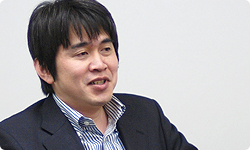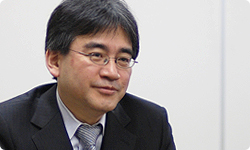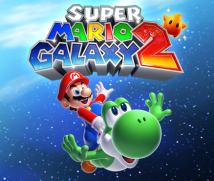5. Mario Is Like a Musical Instrument
Miyamoto-san said that when he talked with you, he realised something important and it was a big relief.
Yes. It was a relief for me, too. I don’t know what Miyamoto-san told you in your most recent discussion for “Iwata Asks,” but the theme - the keyword - this time was resonance.
Miyamoto-san said the exact same thing.
Oh, is that right? I’ve worked together with Miyamoto-san ever since Mario 64, and he always says that in this line of work you have to create both resonance and a sense of the unusual. If that balance breaks down, the game doesn’t work.
If nothing is unusual, it isn’t striking, and if it doesn’t resonate, no one wants to stick with it.
That’s right. The conclusion we reached during that conversation was that when you want to surprise players, you have a tendency to place emphasis on the unusual, but toward the beginning of the game, resonance is very important, and as the game progresses, it then becomes important to gradually increase the element of the unusual. Mr. Miyamoto and I spent time and came to such conclusions.
And that’s reflected in this game?
I believe it is. And I noticed one other thing by talking with Miyamoto-san this time. I started learning guitar recently, and my reason for starting is related to that. When I try to make a game into a single package, I always try to encompass it via a story. But this time, after thinking it through in a number of different ways, I thought maybe a Mario game is a kind of musical instrument.
A musical instrument?
For example, if someone hands you a Mario game, you can play all kinds of different ways, but a first-time player just walks around and maybe jumps once. That’s like playing a single string on a guitar. Then, when you get a little better, you do a Wall Jump, like playing two strings. You play the same song over and over again, and get better and better, and in the end, you can use all six strings and have more and more fun. I think that’s like Mario. Our job is to make a song that you enjoy as you improve.

That’s what you do when you do game design and make maps and so on.
Yes. In the end, you reach the goal and the song ends. It’s a very approachable musical instrument designed so that anyone can play it.
The pleasure you feel when you are able to play a musical instrument well and the feeling when Mario runs, jumps and Wall Jumps just the way you want must be quite similar.
I think everyone wants to play a musical instrument well, and they want to play Mario well, but they can’t do it right away. Nonetheless, that feeling of wanting to do it well is the same. Some people may feel like Super Mario Galaxy 2 looks like it’s more difficult than New Super Mario Bros. Wii15, but the essence is the same - the musical instrument that is Mario. So while there may be several more strings, if you play until your hands become accustomed to it, you will be able to play the way you want. 15New Super Mario Bros. Wii: A platform game released in South Africa in November 2009 for the Wii console.
I see.
The objective of a Mario game is reaching the goal, and each course is, in musical terms, like one or two measures. This game made me realise for the first time that the way we make Mario games is to leave it up to the players how they want to arrange and play the “music” on their way to the goal. And aside from actions involving items, the character of Mario can basically do whatever he wants from the very start.
You can do Wall Jumps from the start, and Ground Pounds and Backward Somersaults.
Right. Link in the Zelda games gathers items one by one to power up, but Mario starts off being able to do everything. That’s just like a musical instrument. A musical instrument can play any kind of complicated music from the very beginning, but you engage with it at your own pace and then gradually improve.
The value of the experience lies in the player’s hands.

That’s right. I realised that our objective isn’t telling a story, it’s making a tool.
I see. Koizumi-san said that Mario Galaxy 2 has several more strings than New Super Mario Bros. Wii. What do the rest of you think about that?
This is just my own personal impression, but I think New Super Mario Bros. Wii is a more difficult game. I actually think there are plenty of stages in Mario Galaxy 2 that people who can only handle one or two strings can clear fairly easily. There really aren’t that many control buttons, and it is, after all, a Mario game just like the others, so I think people who have played the 2D games will be able to find enjoyment in the world of 3D Mario as well and will quickly get deep into it.
New Super Mario Bros. Wii definitely isn’t an easy game, but when people lose a turn, they accept that and then feel like trying again. When you do, your fingers gain experience, and the next thing you notice, you can do all kinds of moves and keep on playing. While the Mario Galaxy series may employ a completely different system, one involving gravity, the hurdles that such elements present have been lowered, and only the number of strings has changed. It’s actually the same kind of Mario game.
I think that’s right.
